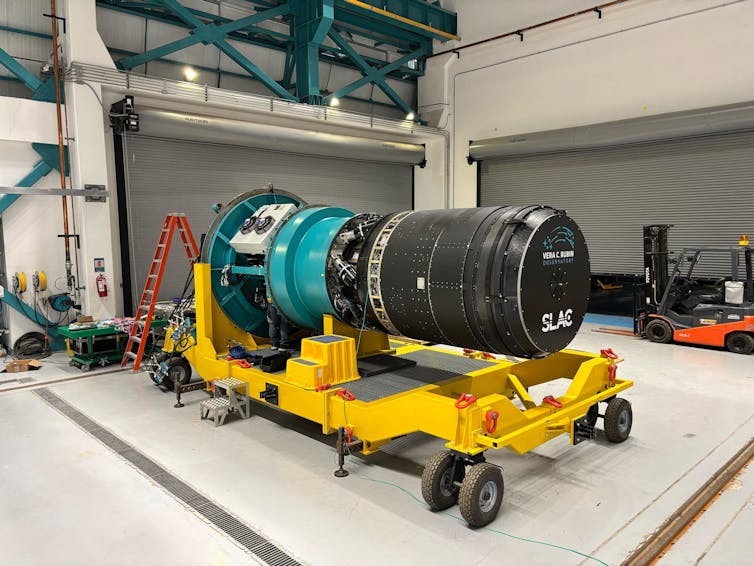A new observatory is assembling the most complete time-lapse record of the night sky ever
On 23 June 2025, the world will get a look at the first images from one of the most powerful telescopes ever built: the Vera C. Rubin Observatory.
Perched high in the Chilean Andes, the observatory will take hundreds of images of the southern hemisphere sky, every night for 10 years. In doing so, it will create the most complete time-lapse record of our Universe ever assembled. This scientific effort is known as the Legacy Survey of Space and Time (LSST).
Rather than focusing on small patches of sky, the Rubin Observatory will scan the entire visible southern sky every few nights. Scientists will use this rolling deep-sky snapshot to track supernovae (exploding stars), asteroids, black holes, and galaxies as they evolve and change in real time. This is astronomy not as a static snapshot, but as a cosmic story unfolding night by night.
At the heart of the observatory lies a remarkable piece of engineering: a digital camera the size of a small car and weighing over three tonnes. With a staggering 3,200 megapixels, each image it captures has enough detail to spot a golf ball from 25km away.
Get your news from actual experts, straight to your inbox. Sign up to our daily newsletter to receive all The Conversation UK’s latest coverage of news and research, from politics and business to the arts and sciences.
Each image is so detailed that it would take hundreds of ultra-high-definition TV screens to display it in full. To capture the universe in colour, the camera uses enormous filters — each about the size of a dustbin lid — that allow through different types of light, from ultraviolet to near-infrared.
The observatory was first proposed in 2001, and construction at the Cerro Pachón ridge site in northern Chile began in April 2015. The first observations with a low-resolution test camera were carried out in October 2024, setting up the first images using the main camera, to be unveiled in June.
Big questions
The observatory is designed to tackle some of astronomy’s biggest questions. For instance, by measuring how galaxies cluster and move, the Rubin Observatory will help scientists investigate the nature of dark energy, the mysterious force driving the accelerating expansion of the Universe.
As a primary goal, it will map the large-scale structure of the Universe and investigate dark matter, the invisible form of matter that makes up 27% of the cosmos. Dark matter acts as the “scaffolding” of the universe, a web-like structure that provides a framework for the formation of galaxies.
The observatory is named after the US astronomer Dr Vera Rubin, whose groundbreaking work uncovered the first strong evidence for dark matter – the very phenomenon this telescope will explore in unprecedented detail.
As a woman in a male-dominated field, Rubin overcame numerous obstacles and remained a tireless advocate for equality in science. She died in 2016 at the age of 88, and her name on this observatory is a tribute not only to her science, but to her perseverance and her legacy of inclusion.
Closer to home, Rubin will help find and track millions of asteroids and other objects that come near Earth – helping warn astronomers of any potential collisions. The observatory will also monitor stars that change in brightness, which can reveal planets orbiting them.
And it will capture rare and fleeting cosmic events, such as the collision of very dense objects called neutron stars, which release sudden bursts of light and ripples in space known as gravitational waves.
What makes this observatory particularly exciting is not just what we expect it to find, but what we can’t yet imagine. Many astronomical breakthroughs have come from chance: strange flashes in the night sky and puzzling movements of objects. Rubin’s massive, continuous data stream could reveal entirely new classes of objects or unknown physical processes.

But capturing this “movie of the universe” depends on something we often take for granted: dark skies. One of the growing challenges facing astronomers is light pollution from satellite mega-constellations – a group of many satellites working together.
These satellites reflect sunlight and can leave bright streaks across telescope images, potentially interfering with the very discoveries Rubin is designed to make. While software can detect and remove some of these trails, doing so adds complexity, cost and can degrade the data.
Fortunately, solutions are already being explored. Rubin Observatory staff are developing simulation tools to predict and reduce satellite interference. They are also working with satellite operators to dim or reposition spacecraft. These efforts are essential – not just for Rubin, but for the future of space science more broadly.
Rubin is a collaboration between the US National Science Foundation and the Department of Energy, with global partners contributing to data processing and scientific analysis. Importantly, much of the data will be publicly available, offering researchers, students and citizen scientists around the world the chance to make discoveries of their own.
The “first-look” event, which will unveil the first images from the observatory, will be livestreamed in English and Spanish, and celebrations are planned at venues around the world.
For astronomers, this is a once-in-a-generation moment – a project that will transform our view of the universe, spark public imagination and generate scientific insights for decades to come.
Noelia Noël does not work for, consult, own shares in or receive funding from any company or organisation that would benefit from this article, and has disclosed no relevant affiliations beyond their academic appointment.


